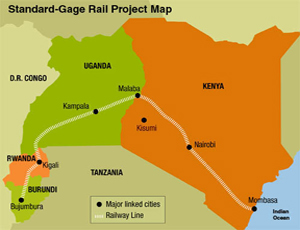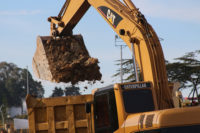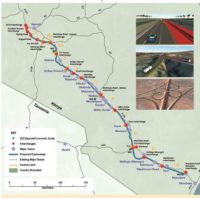Construction of East Africa's first-ever standard-gauge railway, which is being undertaken by Kenya, the region's largest economy, has been pushed back by nine months after Kenya’s railway operator delayed the procurement process for the $3-billion project.
The Kenyan government now has allocated $36 million in the new financial year, which began on July 1, to jump-start the stalled design studies that were initially slated for completion in April, according to Kenyan Finance Minister Uhuru Kenyatta.

The 970-kilometer standard-gauge railway (SGR) will link the Indian Ocean port of Mombasa with Malaba, on the Kenya/Uganda border, with actual construction having been pushed back to September 2012 from December 2011.
“I now expect Kenya Railways Corporation to proceed to conclude the design study by November 2011 to provide us with the estimated cost, routing and implementation arrangements,” the minister said in Nairobi on June 8, 2011, after announcing the $36-million allocation.
The new 1,435-mm gauge railway line, which will pave the way for the introduction of double-decker passenger trains, will link Mombasa with Nairobi, the capital, a distance of 500 km, before being extended to the Kenya/Uganda border town of Malaba, running through the towns of Nakuru and Kisumu for another 420 km. The railway line has the capacity to expand to neighboring Uganda, Rwanda and Burundi, according to Nduva Muli, KRC managing director.
Muli said the new SGR line will run through Kenya from east to west, serving the bottom half of the country, and will run parallel with the existing meter gauge track that is currently being managed by Rift Valley Railways, a consortium led by Egypt's private equity firm Citadel Capital.
Muli said the existing meter gauge railway network “is grappling with challenges, including obsolescence with limited capacity in tonnage and speed.”
“The Northern Corridor (which will include the new railway) is the transport artery for Kenya, Uganda, Northern Tanzania, Rwanda, Burundi, Eastern Democratic Republic of Congo, Southern Sudan and Ethiopia—a region larger than Western Europe,” Muli said.
The new railway line will have 2-km passing loops after an interval of 30 km. It will also involve 60-km rails welded together on concrete sleepers to accommodate the 180-km/hour passenger trains and the 120-km/hour freight trains.
“When completed, this project is expected to reduce the cost of transportation and make our products competitive by at least 70 percent [and reduce] demand for imported fuel oil by 30 percent, thus cushioning our country against high international oil price shocks,” Kenyatta said.
The government, Muli said, is considering a public/private partnership model that would see the government develop, own, manage, maintain and ensure safety of the infrastructure, while a private firm takes up the rolling stock ownership and train operation.
If the implementation plan goes as scheduled, the Nairobi-Mombasa section of the railway line should be commissioned in August 2014, while that of Nairobi-Kisumu-Malaba would be completed in 2017.













Post a comment to this article
Report Abusive Comment